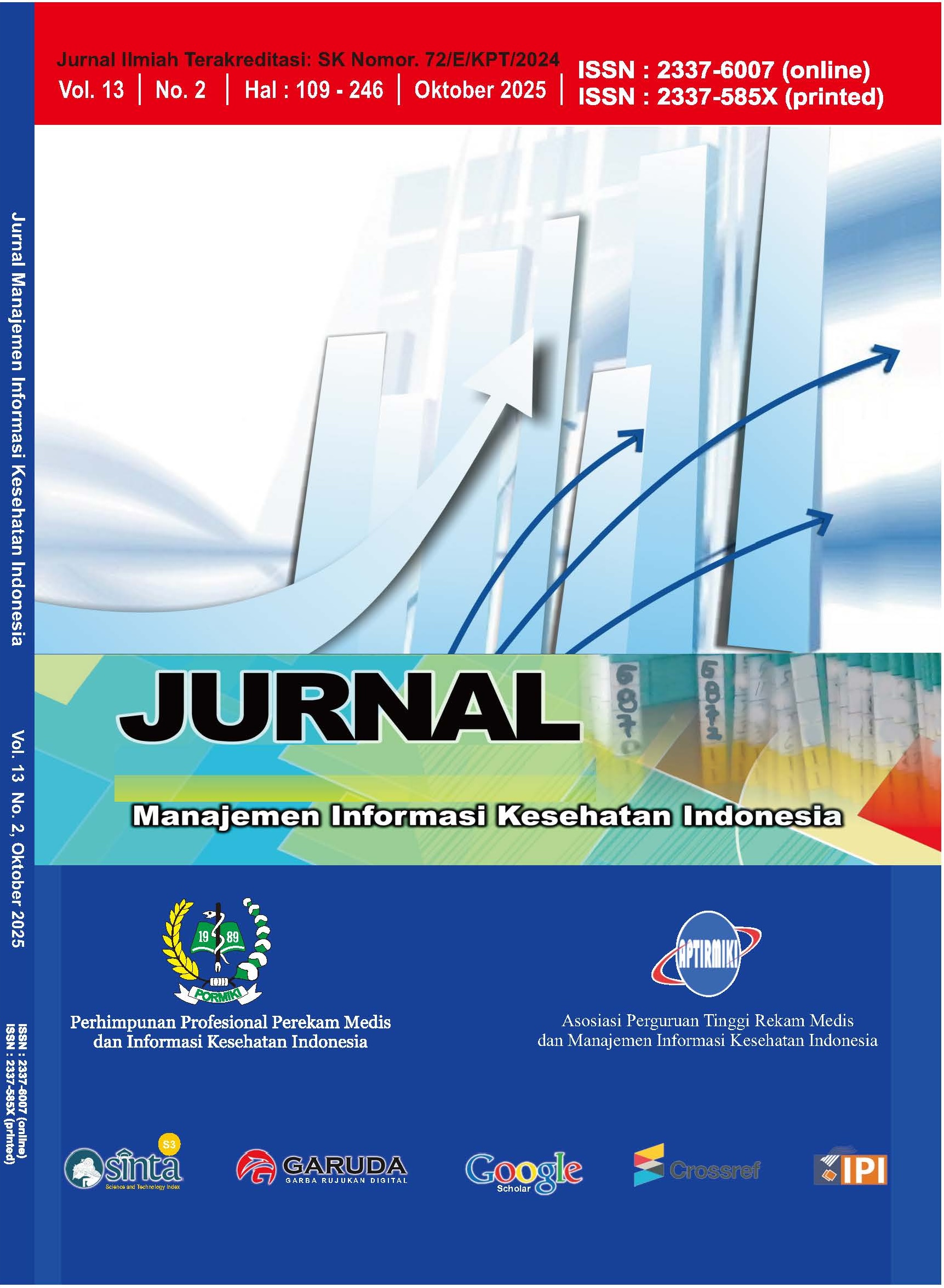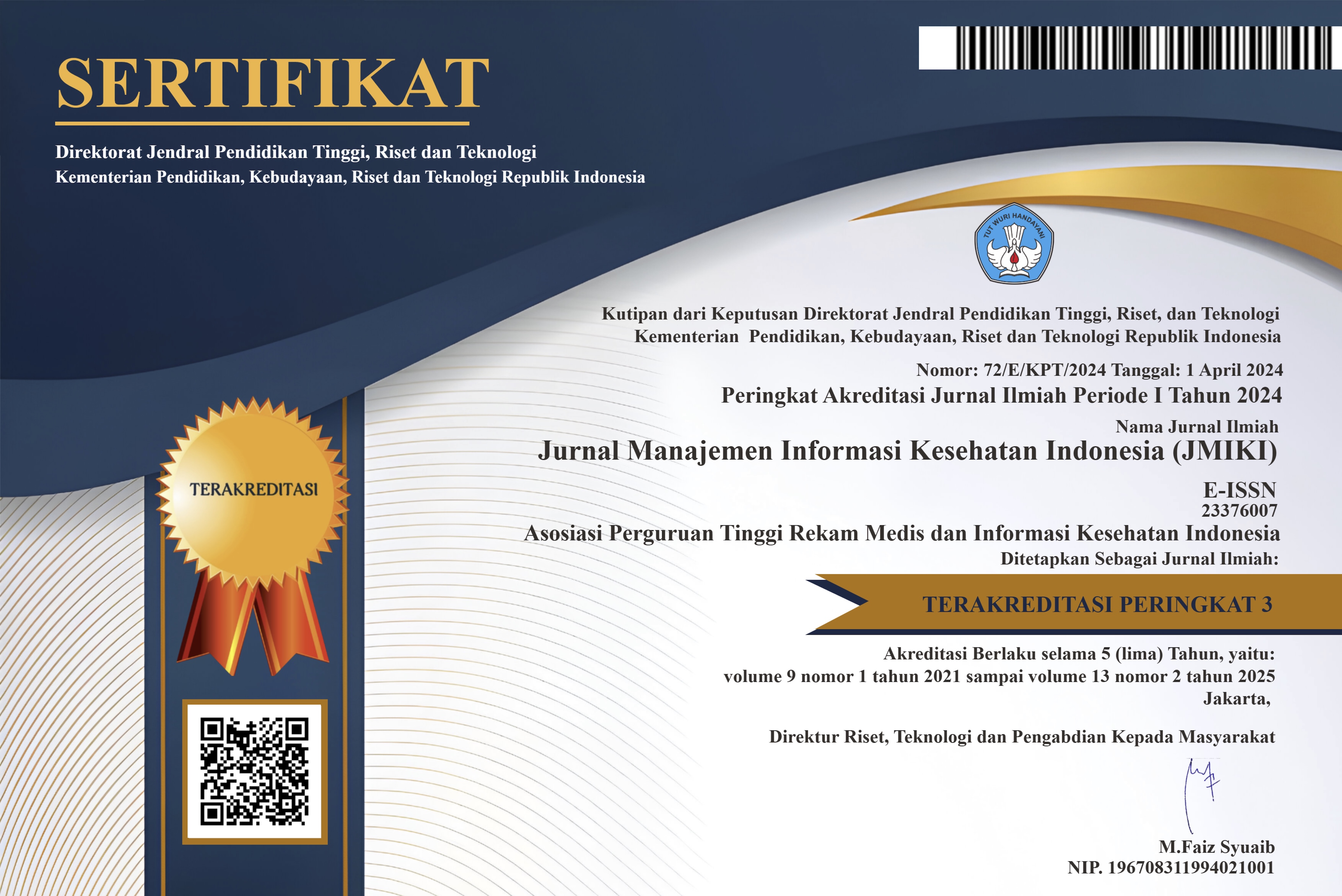Evaluasi RME Rawat Jalan Menggunakan Metode EUCS di RSUD Ngudi Waluyo Wlingi
DOI:
https://doi.org/10.33560/jmiki.v13i2.728Abstract
Obstacles were found in the development of RME at Ngudi Waluyo Wlingi Regional Hospital, namely that there were registration form items that were not used, x-ray results sometimes did not appear resulting in doctors looking at the printed results, and there was no RME user manual. This study aims to evaluate outpatient RME using the EUCS method. This research is a quantitative descriptive study using the end-user computing satisfaction method. The total sample was 54 respondents using the Lemeshow formula. The data collection technique is by distributing questionnaires. User satisfaction analysis, namely the results of respondents' answers, is calculated for each variable, namely content, accuracy, format, timeliness, ease of use. The results are compared between expectations and the reality received by the user. Users are very satisfied if reality is greater than expectations. Users are satisfied if reality is the same as expectations. Users are dissatisfied if expectations are greater than reality. The research results showed that 38.89% of respondents were dissatisfied with content, 37.04% of respondents were dissatisfied with accuracy, 27.78% of respondents were dissatisfied with format, 29.63% of respondents were dissatisfied with timeliness, there were 42, 59% of respondents were not satisfied with ease of use. The suggestions given are for Ngudi Waluyo Wlingi Regional Hospital to review the output produced by RME, add validation warnings when input duplication occurs, develop the RME interface, and create a manual book for using RME.
Downloads
References
Armadani, D. (2023). Evaluasi Sistem Informasi Manajemen Puskesmas (SIMPUS) di Puskesmas Tanjunganom dengan Menggunakan Metode EUCS. Jember: Politenik Negeri Jember.
Audina, N. (2018). Analisis Tingkat Kepuasan Pengguna Sistem Informasi Penelusuran Perkara pada Pengadilan Agama Palembang Menggunakan Model End User Computing Satisfaction (EUCS). Palembang: Universitas Islam Negeri Raden Fatah.
Doll, W. J., & Torkzadeh, G. (1988). The Measurement of End-User Computing Satisfaction End-User Satisfaction. MIS Quarterly, 12(2), 259–274. Retrieved from https://www.jstor.org/stable/248851
Febriani, I. D., Pangestu, I. A., Gee, S., Hulu, L. P., & Wijoyo, A. (2023). Sistem Informasi Manajemen dalam Menunjang Pengambilan Keputusan. Jurnal Riset Informatika dan Inovasi, 1(2), 473–482.
Kemenkes. (2008). Peraturan Menteri Kesehatan Republik Indonesia Nomor 269/Menkes/Per/III/2008 Tentang Rekam Medis. Republik Indonesia, 2008, 7.
Kemenkes. (2021). Cetak Biru Strategi Transformasi Digital Kesehatan 2024. Jakarta: Digital Transformation Office Kementerian Kesehatan Republik Indonesia.
Kemenkes. (2022). Peraturan Menteri Kesehatan Republik Indonesia Nomor 24 Tahun 2022 Tentang Rekam Medis. (8.5.2017), 20. Retrieved from https://yankes.kemkes.go.id/unduhan/fileunduhan_1662611251_882318.pdf
Latoe, V. A. (2019). Pengaruh Persepsi Kemudahan Penggunaan, Persepsi Manfaat, Kualitas Sistem Informasi, dan Kualitas Informasi Terhadap Kepuasan Pengguna Sistem Informasi Akuntansi. Yogyakarta: Universitas Islam Indonesia.
Ludwick, D. A., & Doucette, J. (2009). Adopting Electronic Medical Records in Primary Care: Lessons Learned from Health Information Systems Implementation Experience in Seven Countries. International Journal of Medical Informatics, 78(1), 22–31. https://doi.org/10.1016/j.ijmedinf.2008.06.005
Nugroho, R., Hidayat, M., Devi, E., Rianti, D., Luh, N., Citra Mutiarahati, A., & Rosyid, A. F. (2023). Pemanfaatan Teknologi Digital dalam Pelayanan Kesehatan Publik: Sebuah Tinjauan Analisis Kebijakan. Jurnal Birokrasi & Pemerintahan Daerah, 5(2).
Ramli, M. (2022). Preferensi Laki-Laki dan Perempuan dalam Memilih Fasilitas Pelayanan Kesehatan pada Pasien di Puskesmas Kassi-Kassi. Jurnal Predestination, 2, 1–11.
Republik Indonesia. (2009). Undang-Undang Republik Indonesia Nomor 44 Tahun 2009 Tentang Rumah Sakit. Sekretariat Negara, 2(5), 255.
Rokhman, N., Ningtyas, A. M., Salim, M. F., & Santoso, D. B. (2020). Penerapan Sistem Data Cleansing untuk Mencegah dan Menghilangkan Duplikasi Rekam Medis. Jurnal Pengabdian Kepada Masyarakat (Indonesian Journal of Community Engagement), 6(4). https://doi.org/10.22146/jpkm.51073
Ross, J. (2009). Electronic Medical Records: The Promises and Challenges. Journal of Perianesthesia Nursing, 24(5), 327–329. https://doi.org/10.1016/j.jopan.2009.08.002
Soewandi, E. F. J., & Lukman, H. (2020). Pengaruh Manfaat, Kemudahan Penggunaan, Privasi, dan Peningkatan Kinerja Seseorang dalam Pengadopsian Cloud Computing. Jurnal Multiparadigma Akuntansi Tarumanagara, 2(2), 836–844.
Sugiyono. (2019). Metode Penelitian Evaluasi (Pendekatan Kuantitatif, Kualitatif, dan Kombinasi). Bandung: Alfabeta.
Wiguna, A. S., & Matondang, S. S. (2018). Analisis Desain Formulir Ringkasan Masuk dan Keluar Pasien Rawat Inap di Rumah Sakit Umum Madani Medan Tahun 2018. Jurnal Ilmiah Perekam Dan Informasi Kesehatan IMELDA, 3(1), 1–8.
Yindrizal. (2021). Dampak Penggunaan Sistem Informasi Akademik Untuk Meningkatkan Kualitas Pelayanan Akademik Mahasiswa Universitas Andalas Padang. Jurnal Manajemen Publik & Kebijakan Publik, 3(1), 1–13.
Downloads
Published
How to Cite
Issue
Section
License
Copyright (c) 2025 Rossalina Adi Wijayanti, Nur Cholis Abdul Rohman, Ervina Rachmawati, Angga Rahagiyanto

This work is licensed under a Creative Commons Attribution-ShareAlike 4.0 International License.





